Interpersonal Communication in the Digital Age Essay
VerifiedAdded on 2022/11/13
|9
|1617
|412
Essay
AI Summary
This essay delves into the realm of online communication, examining its profound influence on interpersonal relationships. It highlights how digital technologies have revolutionized communication, eliminating barriers of time, distance, and physical presence. The essay discusses the advantages of online communication, such as convenience and broader platforms for interaction, while also acknowledging potential drawbacks, such as the loss of genuine face-to-face interaction. The study explores the elimination of barriers in interpersonal communication through online platforms and provides an annotated bibliography and references to support its claims. The essay concludes by emphasizing the convenience of online communication, particularly for millennials, while recognizing the irreplaceable value of in-person interactions. This essay is a valuable resource for understanding the evolving dynamics of communication in the digital age.
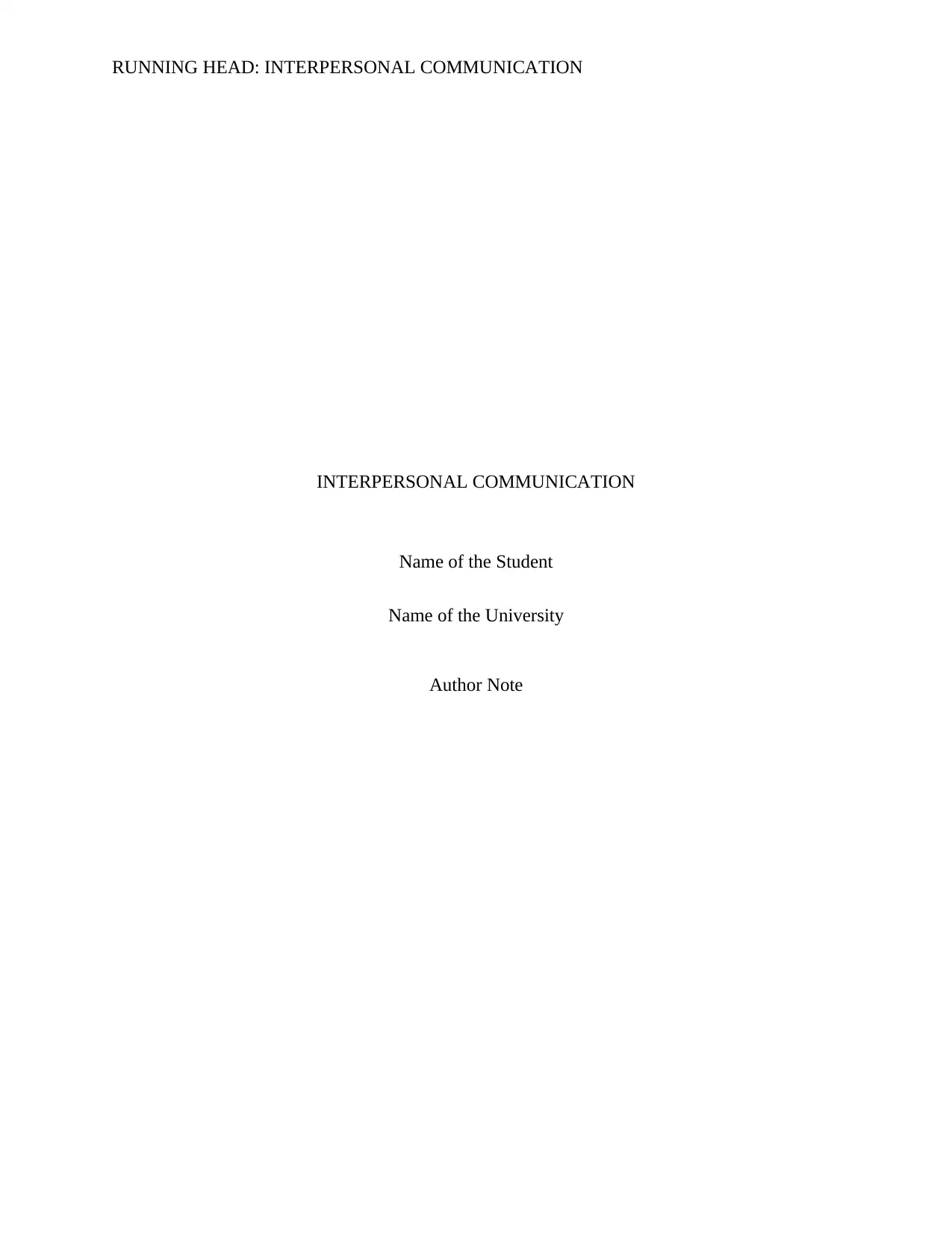
RUNNING HEAD: INTERPERSONAL COMMUNICATION
INTERPERSONAL COMMUNICATION
Name of the Student
Name of the University
Author Note
INTERPERSONAL COMMUNICATION
Name of the Student
Name of the University
Author Note
Paraphrase This Document
Need a fresh take? Get an instant paraphrase of this document with our AI Paraphraser
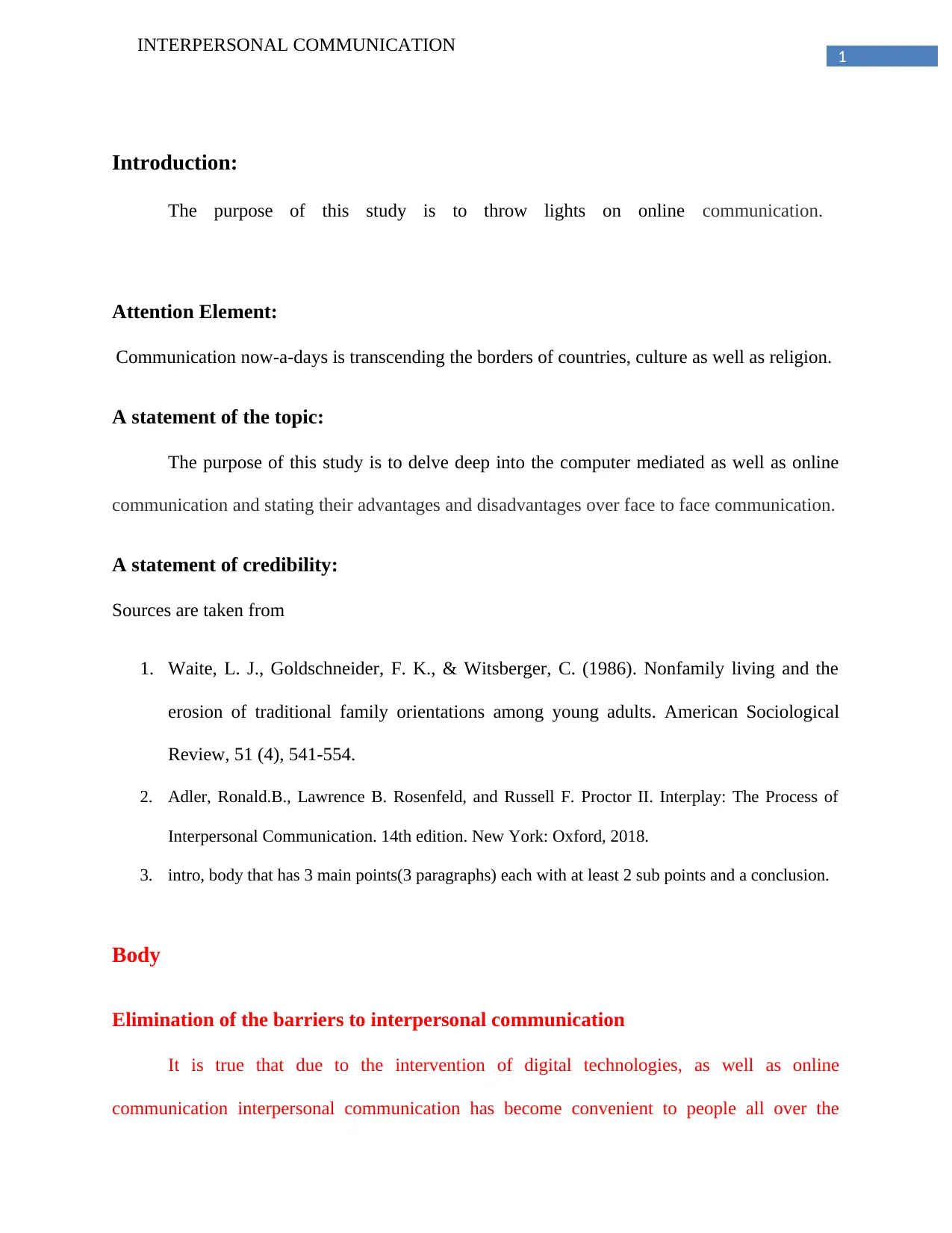
1
INTERPERSONAL COMMUNICATION
Introduction:
The purpose of this study is to throw lights on online communication.
Attention Element:
Communication now-a-days is transcending the borders of countries, culture as well as religion.
A statement of the topic:
The purpose of this study is to delve deep into the computer mediated as well as online
communication and stating their advantages and disadvantages over face to face communication.
A statement of credibility:
Sources are taken from
1. Waite, L. J., Goldschneider, F. K., & Witsberger, C. (1986). Nonfamily living and the
erosion of traditional family orientations among young adults. American Sociological
Review, 51 (4), 541-554.
2. Adler, Ronald.B., Lawrence B. Rosenfeld, and Russell F. Proctor II. Interplay: The Process of
Interpersonal Communication. 14th edition. New York: Oxford, 2018.
3. intro, body that has 3 main points(3 paragraphs) each with at least 2 sub points and a conclusion.
Body
Elimination of the barriers to interpersonal communication
It is true that due to the intervention of digital technologies, as well as online
communication interpersonal communication has become convenient to people all over the
INTERPERSONAL COMMUNICATION
Introduction:
The purpose of this study is to throw lights on online communication.
Attention Element:
Communication now-a-days is transcending the borders of countries, culture as well as religion.
A statement of the topic:
The purpose of this study is to delve deep into the computer mediated as well as online
communication and stating their advantages and disadvantages over face to face communication.
A statement of credibility:
Sources are taken from
1. Waite, L. J., Goldschneider, F. K., & Witsberger, C. (1986). Nonfamily living and the
erosion of traditional family orientations among young adults. American Sociological
Review, 51 (4), 541-554.
2. Adler, Ronald.B., Lawrence B. Rosenfeld, and Russell F. Proctor II. Interplay: The Process of
Interpersonal Communication. 14th edition. New York: Oxford, 2018.
3. intro, body that has 3 main points(3 paragraphs) each with at least 2 sub points and a conclusion.
Body
Elimination of the barriers to interpersonal communication
It is true that due to the intervention of digital technologies, as well as online
communication interpersonal communication has become convenient to people all over the
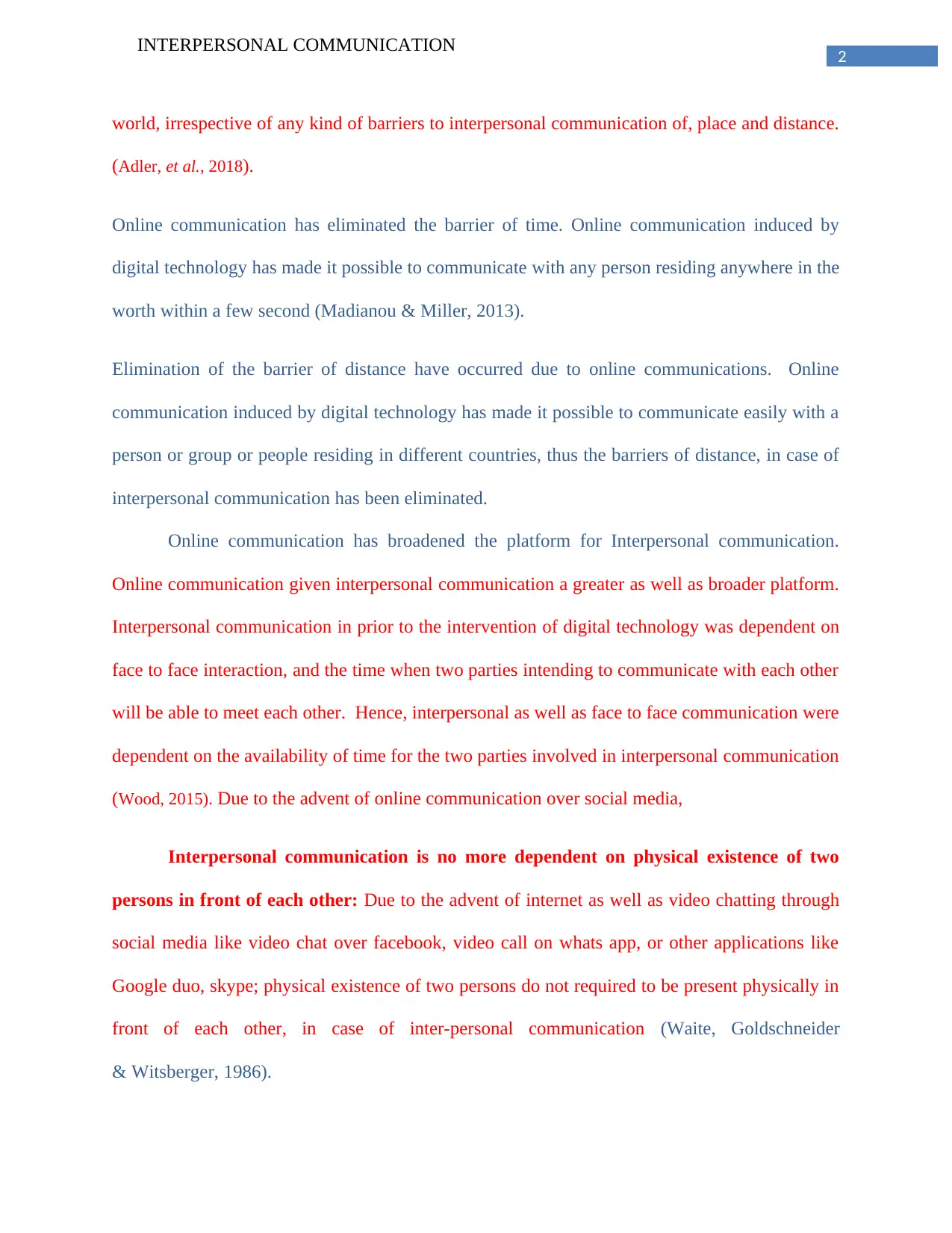
2
INTERPERSONAL COMMUNICATION
world, irrespective of any kind of barriers to interpersonal communication of, place and distance.
(Adler, et al., 2018).
Online communication has eliminated the barrier of time. Online communication induced by
digital technology has made it possible to communicate with any person residing anywhere in the
worth within a few second (Madianou & Miller, 2013).
Elimination of the barrier of distance have occurred due to online communications. Online
communication induced by digital technology has made it possible to communicate easily with a
person or group or people residing in different countries, thus the barriers of distance, in case of
interpersonal communication has been eliminated.
Online communication has broadened the platform for Interpersonal communication.
Online communication given interpersonal communication a greater as well as broader platform.
Interpersonal communication in prior to the intervention of digital technology was dependent on
face to face interaction, and the time when two parties intending to communicate with each other
will be able to meet each other. Hence, interpersonal as well as face to face communication were
dependent on the availability of time for the two parties involved in interpersonal communication
(Wood, 2015). Due to the advent of online communication over social media,
Interpersonal communication is no more dependent on physical existence of two
persons in front of each other: Due to the advent of internet as well as video chatting through
social media like video chat over facebook, video call on whats app, or other applications like
Google duo, skype; physical existence of two persons do not required to be present physically in
front of each other, in case of inter-personal communication (Waite, Goldschneider
& Witsberger, 1986).
INTERPERSONAL COMMUNICATION
world, irrespective of any kind of barriers to interpersonal communication of, place and distance.
(Adler, et al., 2018).
Online communication has eliminated the barrier of time. Online communication induced by
digital technology has made it possible to communicate with any person residing anywhere in the
worth within a few second (Madianou & Miller, 2013).
Elimination of the barrier of distance have occurred due to online communications. Online
communication induced by digital technology has made it possible to communicate easily with a
person or group or people residing in different countries, thus the barriers of distance, in case of
interpersonal communication has been eliminated.
Online communication has broadened the platform for Interpersonal communication.
Online communication given interpersonal communication a greater as well as broader platform.
Interpersonal communication in prior to the intervention of digital technology was dependent on
face to face interaction, and the time when two parties intending to communicate with each other
will be able to meet each other. Hence, interpersonal as well as face to face communication were
dependent on the availability of time for the two parties involved in interpersonal communication
(Wood, 2015). Due to the advent of online communication over social media,
Interpersonal communication is no more dependent on physical existence of two
persons in front of each other: Due to the advent of internet as well as video chatting through
social media like video chat over facebook, video call on whats app, or other applications like
Google duo, skype; physical existence of two persons do not required to be present physically in
front of each other, in case of inter-personal communication (Waite, Goldschneider
& Witsberger, 1986).
⊘ This is a preview!⊘
Do you want full access?
Subscribe today to unlock all pages.

Trusted by 1+ million students worldwide
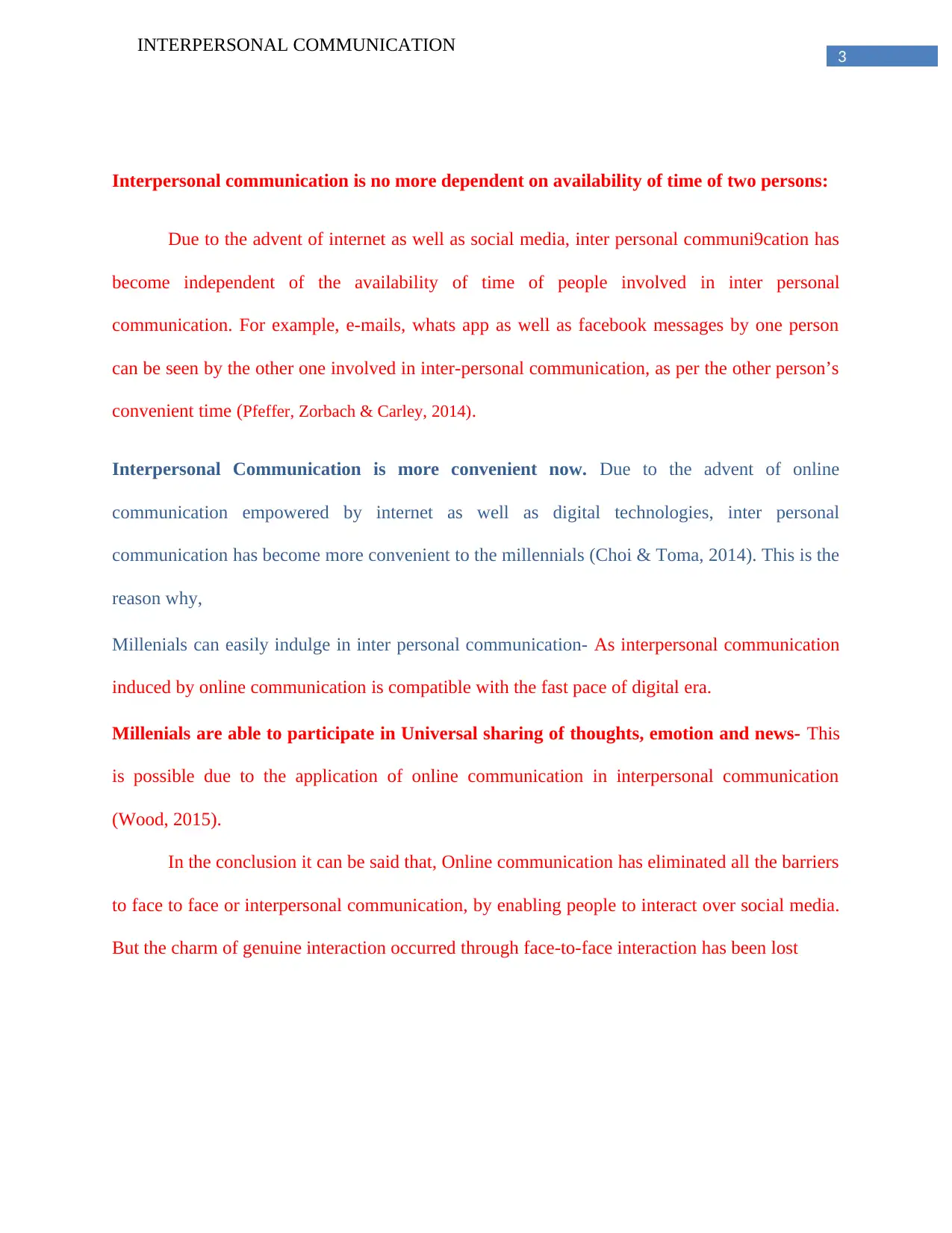
3
INTERPERSONAL COMMUNICATION
Interpersonal communication is no more dependent on availability of time of two persons:
Due to the advent of internet as well as social media, inter personal communi9cation has
become independent of the availability of time of people involved in inter personal
communication. For example, e-mails, whats app as well as facebook messages by one person
can be seen by the other one involved in inter-personal communication, as per the other person’s
convenient time (Pfeffer, Zorbach & Carley, 2014).
Interpersonal Communication is more convenient now. Due to the advent of online
communication empowered by internet as well as digital technologies, inter personal
communication has become more convenient to the millennials (Choi & Toma, 2014). This is the
reason why,
Millenials can easily indulge in inter personal communication- As interpersonal communication
induced by online communication is compatible with the fast pace of digital era.
Millenials are able to participate in Universal sharing of thoughts, emotion and news- This
is possible due to the application of online communication in interpersonal communication
(Wood, 2015).
In the conclusion it can be said that, Online communication has eliminated all the barriers
to face to face or interpersonal communication, by enabling people to interact over social media.
But the charm of genuine interaction occurred through face-to-face interaction has been lost
INTERPERSONAL COMMUNICATION
Interpersonal communication is no more dependent on availability of time of two persons:
Due to the advent of internet as well as social media, inter personal communi9cation has
become independent of the availability of time of people involved in inter personal
communication. For example, e-mails, whats app as well as facebook messages by one person
can be seen by the other one involved in inter-personal communication, as per the other person’s
convenient time (Pfeffer, Zorbach & Carley, 2014).
Interpersonal Communication is more convenient now. Due to the advent of online
communication empowered by internet as well as digital technologies, inter personal
communication has become more convenient to the millennials (Choi & Toma, 2014). This is the
reason why,
Millenials can easily indulge in inter personal communication- As interpersonal communication
induced by online communication is compatible with the fast pace of digital era.
Millenials are able to participate in Universal sharing of thoughts, emotion and news- This
is possible due to the application of online communication in interpersonal communication
(Wood, 2015).
In the conclusion it can be said that, Online communication has eliminated all the barriers
to face to face or interpersonal communication, by enabling people to interact over social media.
But the charm of genuine interaction occurred through face-to-face interaction has been lost
Paraphrase This Document
Need a fresh take? Get an instant paraphrase of this document with our AI Paraphraser
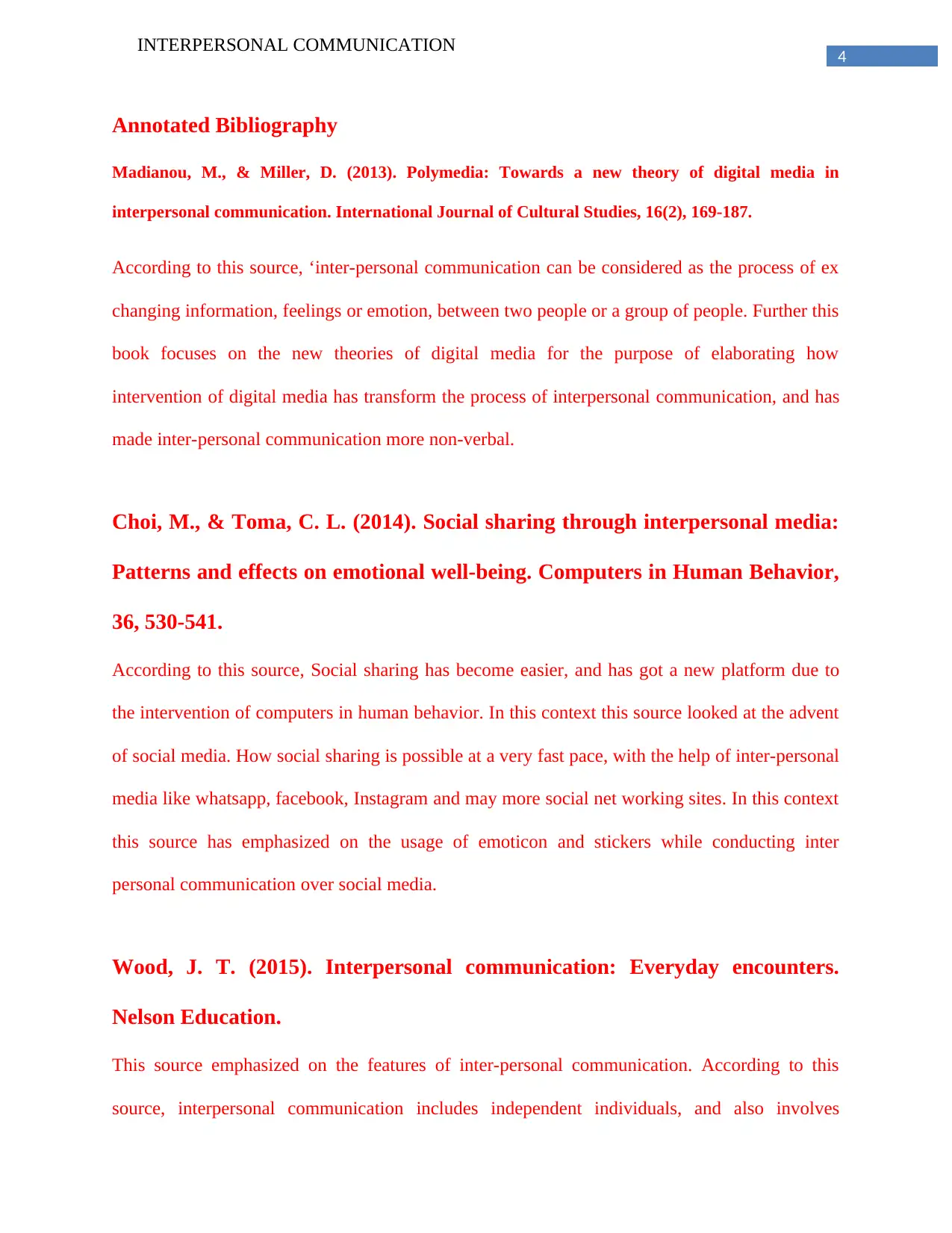
4
INTERPERSONAL COMMUNICATION
Annotated Bibliography
Madianou, M., & Miller, D. (2013). Polymedia: Towards a new theory of digital media in
interpersonal communication. International Journal of Cultural Studies, 16(2), 169-187.
According to this source, ‘inter-personal communication can be considered as the process of ex
changing information, feelings or emotion, between two people or a group of people. Further this
book focuses on the new theories of digital media for the purpose of elaborating how
intervention of digital media has transform the process of interpersonal communication, and has
made inter-personal communication more non-verbal.
Choi, M., & Toma, C. L. (2014). Social sharing through interpersonal media:
Patterns and effects on emotional well-being. Computers in Human Behavior,
36, 530-541.
According to this source, Social sharing has become easier, and has got a new platform due to
the intervention of computers in human behavior. In this context this source looked at the advent
of social media. How social sharing is possible at a very fast pace, with the help of inter-personal
media like whatsapp, facebook, Instagram and may more social net working sites. In this context
this source has emphasized on the usage of emoticon and stickers while conducting inter
personal communication over social media.
Wood, J. T. (2015). Interpersonal communication: Everyday encounters.
Nelson Education.
This source emphasized on the features of inter-personal communication. According to this
source, interpersonal communication includes independent individuals, and also involves
INTERPERSONAL COMMUNICATION
Annotated Bibliography
Madianou, M., & Miller, D. (2013). Polymedia: Towards a new theory of digital media in
interpersonal communication. International Journal of Cultural Studies, 16(2), 169-187.
According to this source, ‘inter-personal communication can be considered as the process of ex
changing information, feelings or emotion, between two people or a group of people. Further this
book focuses on the new theories of digital media for the purpose of elaborating how
intervention of digital media has transform the process of interpersonal communication, and has
made inter-personal communication more non-verbal.
Choi, M., & Toma, C. L. (2014). Social sharing through interpersonal media:
Patterns and effects on emotional well-being. Computers in Human Behavior,
36, 530-541.
According to this source, Social sharing has become easier, and has got a new platform due to
the intervention of computers in human behavior. In this context this source looked at the advent
of social media. How social sharing is possible at a very fast pace, with the help of inter-personal
media like whatsapp, facebook, Instagram and may more social net working sites. In this context
this source has emphasized on the usage of emoticon and stickers while conducting inter
personal communication over social media.
Wood, J. T. (2015). Interpersonal communication: Everyday encounters.
Nelson Education.
This source emphasized on the features of inter-personal communication. According to this
source, interpersonal communication includes independent individuals, and also involves
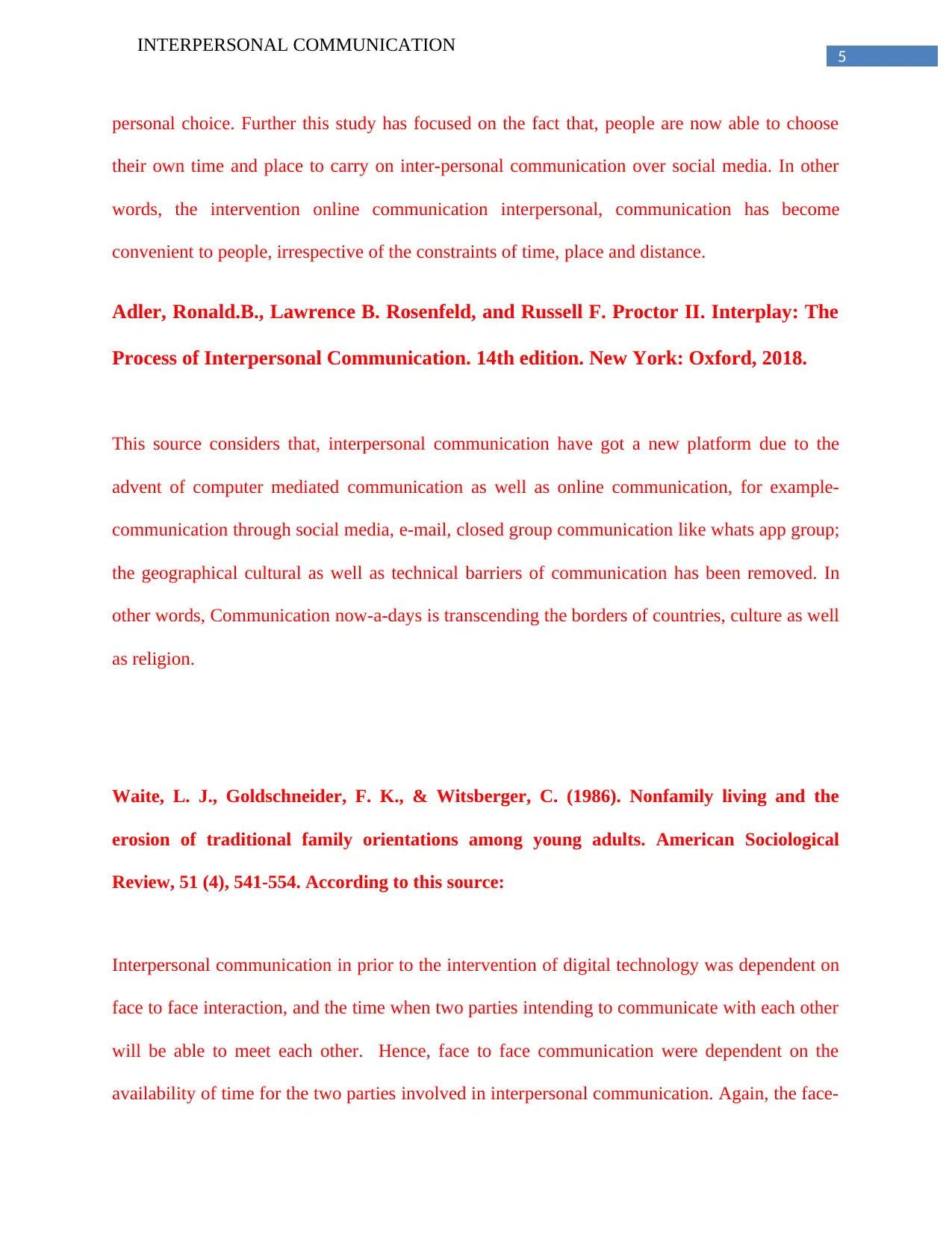
5
INTERPERSONAL COMMUNICATION
personal choice. Further this study has focused on the fact that, people are now able to choose
their own time and place to carry on inter-personal communication over social media. In other
words, the intervention online communication interpersonal, communication has become
convenient to people, irrespective of the constraints of time, place and distance.
Adler, Ronald.B., Lawrence B. Rosenfeld, and Russell F. Proctor II. Interplay: The
Process of Interpersonal Communication. 14th edition. New York: Oxford, 2018.
This source considers that, interpersonal communication have got a new platform due to the
advent of computer mediated communication as well as online communication, for example-
communication through social media, e-mail, closed group communication like whats app group;
the geographical cultural as well as technical barriers of communication has been removed. In
other words, Communication now-a-days is transcending the borders of countries, culture as well
as religion.
Waite, L. J., Goldschneider, F. K., & Witsberger, C. (1986). Nonfamily living and the
erosion of traditional family orientations among young adults. American Sociological
Review, 51 (4), 541-554. According to this source:
Interpersonal communication in prior to the intervention of digital technology was dependent on
face to face interaction, and the time when two parties intending to communicate with each other
will be able to meet each other. Hence, face to face communication were dependent on the
availability of time for the two parties involved in interpersonal communication. Again, the face-
INTERPERSONAL COMMUNICATION
personal choice. Further this study has focused on the fact that, people are now able to choose
their own time and place to carry on inter-personal communication over social media. In other
words, the intervention online communication interpersonal, communication has become
convenient to people, irrespective of the constraints of time, place and distance.
Adler, Ronald.B., Lawrence B. Rosenfeld, and Russell F. Proctor II. Interplay: The
Process of Interpersonal Communication. 14th edition. New York: Oxford, 2018.
This source considers that, interpersonal communication have got a new platform due to the
advent of computer mediated communication as well as online communication, for example-
communication through social media, e-mail, closed group communication like whats app group;
the geographical cultural as well as technical barriers of communication has been removed. In
other words, Communication now-a-days is transcending the borders of countries, culture as well
as religion.
Waite, L. J., Goldschneider, F. K., & Witsberger, C. (1986). Nonfamily living and the
erosion of traditional family orientations among young adults. American Sociological
Review, 51 (4), 541-554. According to this source:
Interpersonal communication in prior to the intervention of digital technology was dependent on
face to face interaction, and the time when two parties intending to communicate with each other
will be able to meet each other. Hence, face to face communication were dependent on the
availability of time for the two parties involved in interpersonal communication. Again, the face-
⊘ This is a preview!⊘
Do you want full access?
Subscribe today to unlock all pages.

Trusted by 1+ million students worldwide
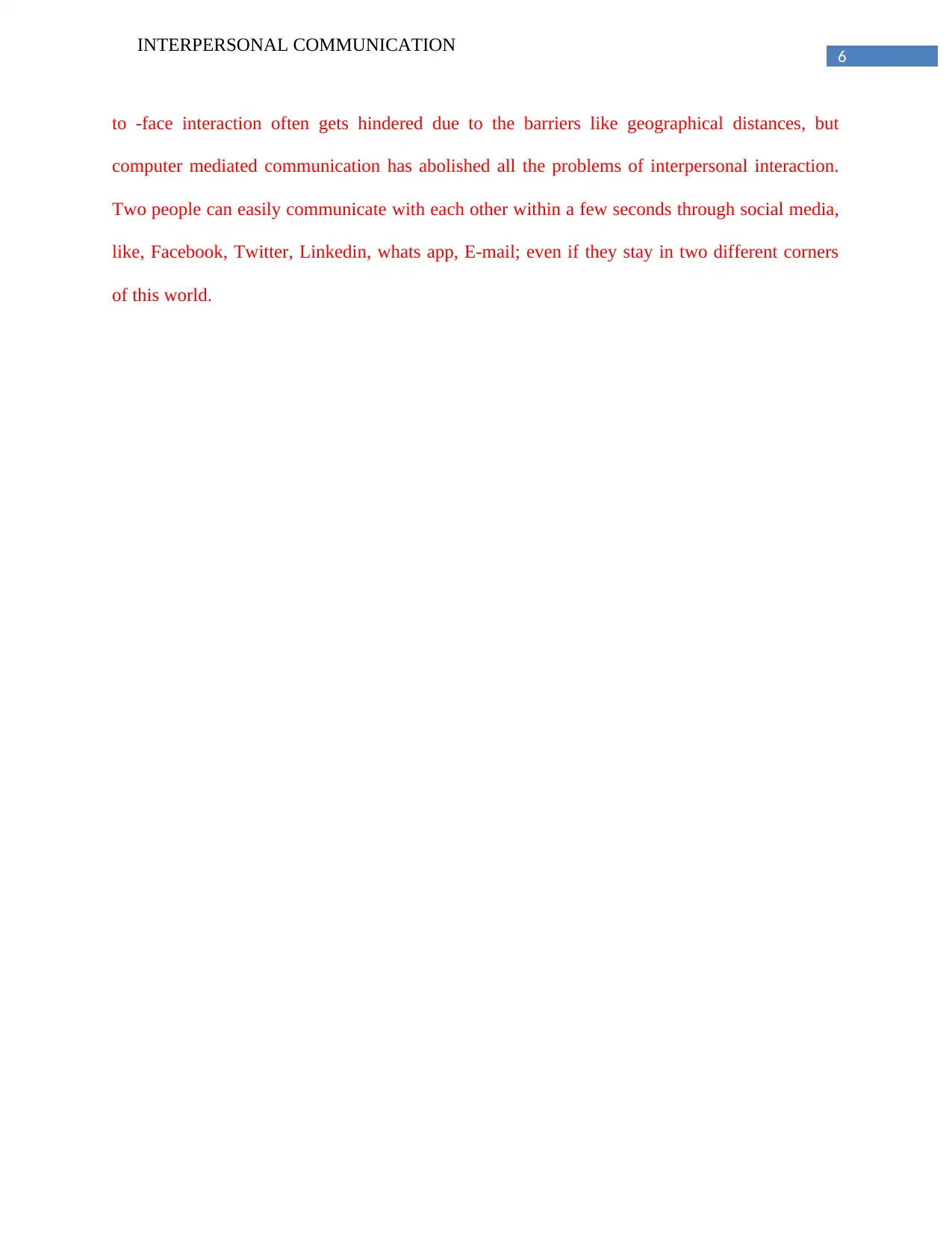
6
INTERPERSONAL COMMUNICATION
to -face interaction often gets hindered due to the barriers like geographical distances, but
computer mediated communication has abolished all the problems of interpersonal interaction.
Two people can easily communicate with each other within a few seconds through social media,
like, Facebook, Twitter, Linkedin, whats app, E-mail; even if they stay in two different corners
of this world.
INTERPERSONAL COMMUNICATION
to -face interaction often gets hindered due to the barriers like geographical distances, but
computer mediated communication has abolished all the problems of interpersonal interaction.
Two people can easily communicate with each other within a few seconds through social media,
like, Facebook, Twitter, Linkedin, whats app, E-mail; even if they stay in two different corners
of this world.
Paraphrase This Document
Need a fresh take? Get an instant paraphrase of this document with our AI Paraphraser
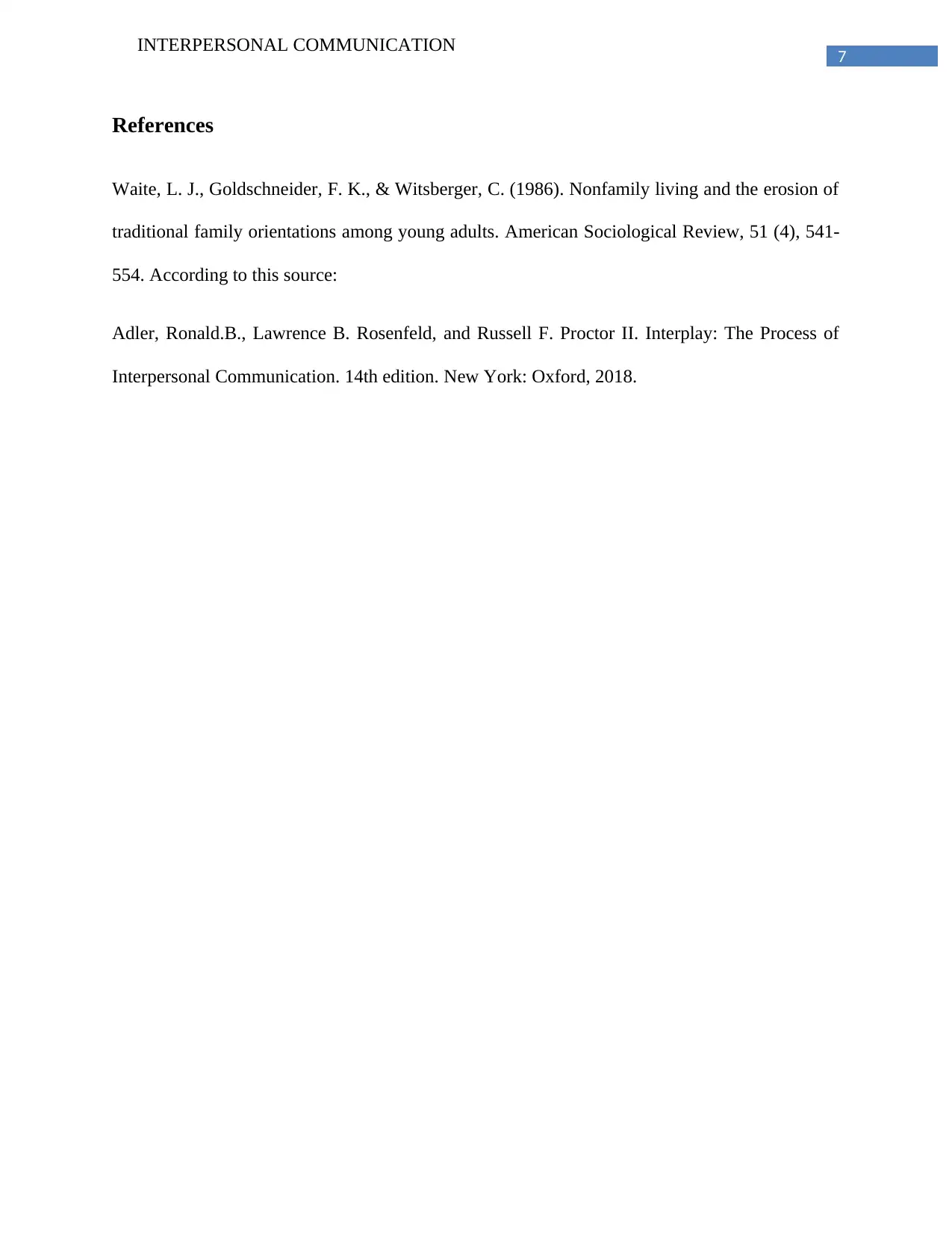
7
INTERPERSONAL COMMUNICATION
References
Waite, L. J., Goldschneider, F. K., & Witsberger, C. (1986). Nonfamily living and the erosion of
traditional family orientations among young adults. American Sociological Review, 51 (4), 541-
554. According to this source:
Adler, Ronald.B., Lawrence B. Rosenfeld, and Russell F. Proctor II. Interplay: The Process of
Interpersonal Communication. 14th edition. New York: Oxford, 2018.
INTERPERSONAL COMMUNICATION
References
Waite, L. J., Goldschneider, F. K., & Witsberger, C. (1986). Nonfamily living and the erosion of
traditional family orientations among young adults. American Sociological Review, 51 (4), 541-
554. According to this source:
Adler, Ronald.B., Lawrence B. Rosenfeld, and Russell F. Proctor II. Interplay: The Process of
Interpersonal Communication. 14th edition. New York: Oxford, 2018.
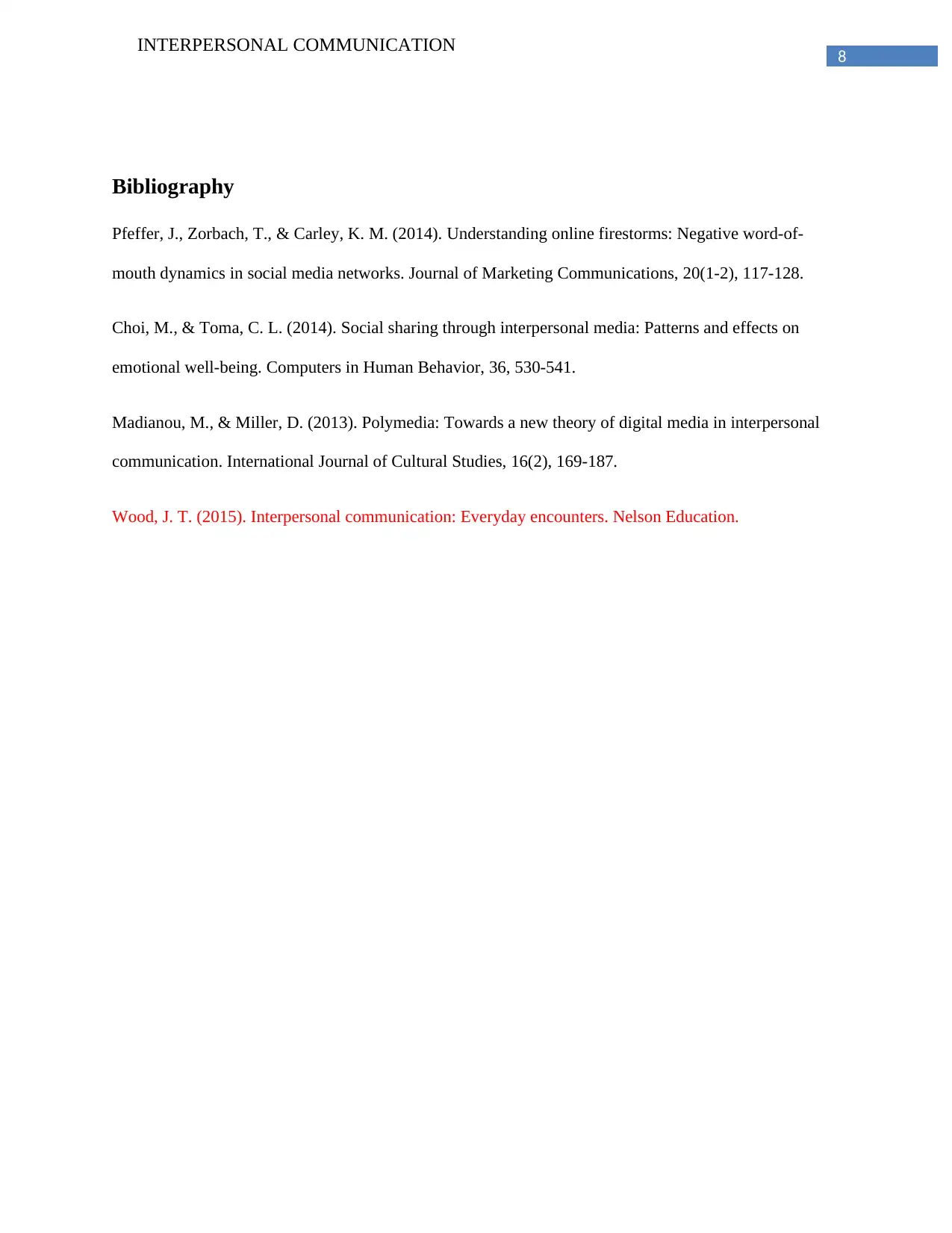
8
INTERPERSONAL COMMUNICATION
Bibliography
Pfeffer, J., Zorbach, T., & Carley, K. M. (2014). Understanding online firestorms: Negative word-of-
mouth dynamics in social media networks. Journal of Marketing Communications, 20(1-2), 117-128.
Choi, M., & Toma, C. L. (2014). Social sharing through interpersonal media: Patterns and effects on
emotional well-being. Computers in Human Behavior, 36, 530-541.
Madianou, M., & Miller, D. (2013). Polymedia: Towards a new theory of digital media in interpersonal
communication. International Journal of Cultural Studies, 16(2), 169-187.
Wood, J. T. (2015). Interpersonal communication: Everyday encounters. Nelson Education.
INTERPERSONAL COMMUNICATION
Bibliography
Pfeffer, J., Zorbach, T., & Carley, K. M. (2014). Understanding online firestorms: Negative word-of-
mouth dynamics in social media networks. Journal of Marketing Communications, 20(1-2), 117-128.
Choi, M., & Toma, C. L. (2014). Social sharing through interpersonal media: Patterns and effects on
emotional well-being. Computers in Human Behavior, 36, 530-541.
Madianou, M., & Miller, D. (2013). Polymedia: Towards a new theory of digital media in interpersonal
communication. International Journal of Cultural Studies, 16(2), 169-187.
Wood, J. T. (2015). Interpersonal communication: Everyday encounters. Nelson Education.
⊘ This is a preview!⊘
Do you want full access?
Subscribe today to unlock all pages.

Trusted by 1+ million students worldwide
1 out of 9
Related Documents
Your All-in-One AI-Powered Toolkit for Academic Success.
+13062052269
info@desklib.com
Available 24*7 on WhatsApp / Email
![[object Object]](/_next/static/media/star-bottom.7253800d.svg)
Unlock your academic potential
Copyright © 2020–2025 A2Z Services. All Rights Reserved. Developed and managed by ZUCOL.





